Woodworking is an art form that requires precision, patience, and the right tools. Specialty woodworking projects require a special set of tools, including chisels.
Did you know that according to a survey of experienced woodworkers, 85% agreed that having the proper chisels on hand was essential for success? Whether you’re new to woodworking or are an experienced artisan looking to expand your toolset, here’s what you need to know about must-have chisels for specialty woodworking projects.
From firmer and mortise chisels to shoulder planes and mallets, we’ll cover it all so you can get started confidently
Key Takeaways
- Having the proper chisels is essential for specialty woodworking.
- Different types of chisels are needed for specific tasks such as firmer chisels for tough cuts, mortise chisels for square holes, paring chisels for delicate cuts, corner chisels for adding details, framing chisels for complex joinery, and carving chisels for creativity.
- When choosing chisels, consider factors such as quality steel construction, ergonomic grips, narrow blades, and ergonomic handles.
- Regular maintenance of chisels, including checking the cutting edge, cleaning, and proper storage, is crucial for durability and longevity.
Firmer Chisel
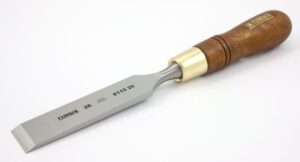
You’ll want a firmer chisel for your specialty woodworking projects, it’ll make quick work of any tough cuts!
A firmer chisel is the most essential tool in any woodworker’s collection. It’s designed to hold its edge over long periods, making it ideal for use on hardwood materials like oak and walnut. Plus, the blade has excellent strength and edge retention capabilities, so you can be sure that your cuts will stay true even with repeated use. The handle is also comfortable enough to use for extended periods without fatigue.
When choosing a firmer chisel, go for one with quality steel construction and an ergonomic grip. Also, look for models that come with a protective sheath or are easy to sharpen yourself. This way you can ensure your tool stays in top condition between uses and makes precise cuts every time.
Overall, a good firmer chisel will give you maximum control while allowing you to tackle even the toughest woodworking tasks quickly and accurately. With proper care and maintenance, it should provide years of reliable service without breaking the bank either.
And transitioning into the next section, a mortise chisel is another must-have when looking at specialty tools for woodworking jobs…
Mortise Chisel
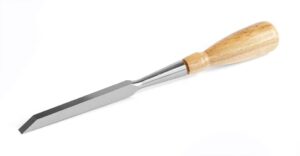
A mortise chisel isn’t something you’d expect to find in a regular toolkit, yet it’s indispensable for tackling intricate woodworking projects. A mortise chisel is used to create a square hole into which a tenon can be placed. This technique is known as installing a Mortise and Tenon joint, and it’s essential for joining two pieces of wood together securely.
There are two main types of Mortise Chisels, Firmer Chisels and Paring Chisels. The Firmer Chisel has a thicker blade, making it ideal for creating large holes in the wood, while the Paring Chisel has a thinner blade that allows users to make more precise cuts.
Mortise chisels come in different sizes and shapes, so you’ll need to choose one that best suits your needs. It’s important to select one with an ergonomic handle that won’t cause strain on your hands during extended use. Additionally, look for one with a double-beveled edge so you can cut on either side of the blade without needing to sharpen it regularly. Lastly, ensure the blades are made from high-quality materials such as stainless steel or carbon steel so they’ll stay sharp longer and reduce wear over time.
Using a Mortise Chisel correctly takes practice, but once mastered, it will provide superior results every time you use it. With its versatile design and durable construction, this type of chisel is perfect for both amateurs and professionals alike who want accurate joins in their workpieces without having to worry about rough edges or uneven cuts. By investing in the right tools like these specialized chisels now, you’ll have everything necessary to tackle any project down the line, no matter how complex!
Transitions between sections go much smoother when all components fit snugly together, allowing your creative vision to take shape quickly and effortlessly.
Paring Chisel
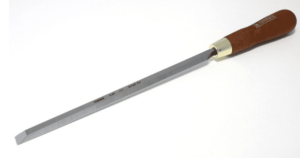
No project isn’t complete without a paring chisel for those delicate, precise cuts that make all the difference! Paring chisels are designed to work with special types of wood, such as softwoods like pine and cedar. They can also be used on hardwoods such as oak and maple.
The blades of these tools are usually narrower than other types of chisels, allowing you to get into tight corners or small spaces. When using a paring chisel, it’s important to take safety precautions by wearing protective gloves and eye protection. Additionally, always use sharp blades; dull blades can slip and cause injury.
Paring chisels come in different sizes depending on the type of wood you’re working with. If you’re cutting intricate patterns in thin pieces of wood, then a smaller blade may be necessary. For thicker pieces of wood, opt for a larger blade size so that it won’t break or bend when pressure is applied.
Finally, keep in mind that accuracy is critical when using this type of tool – take your time and pay attention to detail for the best results! With the right paring chisel in hand, you can achieve clean edges and beautiful finishes every time – making it an essential part of any specialty woodworking project.
Corner Chisel
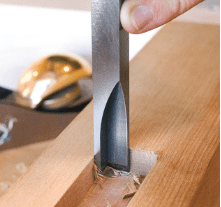
For intricate woodworking projects, you’ll want to equip yourself with a corner chisel. Corner chisels are specialized tools designed for installing corners and adding details to furniture pieces. They have a wide variety of uses, from creating mortise joints on the edges of boards to cutting decorative designs into your project.
The blade is typically angled at 90 degrees, which allows it to reach tight corners that can’t be accessed by other types of chisels. When selecting your corner chisel, look for one with a narrow blade as this’ll give you greater control when working in tight spaces. It should also have an ergonomic handle so you can work comfortably without straining your wrist or arm muscles. The tip should be sharp and well-maintained for precise cuts and smooth results. If you’re looking for even more precision, consider investing in a set of corner chisels that come with interchangeable blades in various sizes and angles.
No matter what type of woodworking project you’re tackling, having a reliable corner chisel will make all the difference when it comes to completing detailed work. With the right tool in hand, adding small details like dovetail joints or notches won’t seem daunting, it can become an enjoyable part of the process! And once you master using the corner chisel, there’s no limit to what beautiful creations you can produce.
Moving onto framing chisel…
Framing Chisel
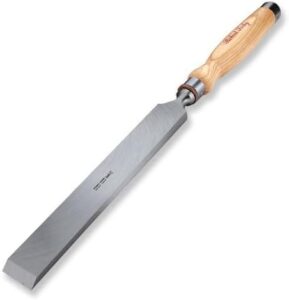
You’ll find endless possibilities with a framing chisel in your toolbox, so don’t miss out on unleashing your creativity! A framing chisel is an essential tool for specialty woodworking that can be used to create complex joinery and intricate designs.
It is designed to allow you to form mortise and tenon joints along with other precise detailing work. This makes it ideal for creating custom frames or joining large panels. It can also help make delicate adjustments in butt joints commonly found in furniture-making projects.
Framing techniques require the use of a framer’s hammer and mallet, jointer planes, and a good-quality chisel that’ll stay sharp over time. A framing chisel should have a wide variety of blade sizes ranging from 3/16′ up to 1′ so that you can tackle any job with precision and accuracy. If you’re looking for even more versatility, then there are also models available with interchangeable blades for different widths of cuts.
The handles of framing chisels come in many shapes and sizes depending on the user’s preference as well as the type of work being done. The handle should provide enough grip while allowing for comfortable maneuverability when forming tight corners or hardwood edges. Quality materials like steel, brass, or carbon fiber are often used to ensure durability throughout years of use without compromising comfort or control.
With these considerations taken into account, it’s easy to see why having a good quality framing chisel is essential to any woodworker who values precision and detail in their projects. With its versatile design and tough construction, this indispensable tool can open up countless possibilities when tackling complex specialty projects that require high levels of craftsmanship!
Carving Chisel
Carving chisels lets you unlock your creativity and craft intricate masterpieces out of wood with ease. Whether you’re a beginner or a professional, these tools are essential for any woodworker.
Carving chisels come in a wide variety of shapes and sizes so it’s important to choose the right one for the job. For best results, start with a set that includes straight gouges, V-gouges, U-gouges, skew chisels, parting tools, and other specialty chisels.
When selecting wood for carving projects, it’s important to choose a material that is dense enough to hold detail but soft enough not to dull the blade too quickly.
Knowing basic sculpting techniques will help you make the most of your carving chisel set. From creating intricate patterns on furniture surfaces to delicate carvings in basswood blocks, there’s an endless array of possibilities when using carving chisels properly.
With practice and patience, anyone can create beautiful works of art from even the simplest of materials. To get started on your next project, all you need is some quality wood and the right set of carving chisels – no matter what skill level you’re at!
Ready to move on to something more specialized? A shoulder plane might be just what you need!
Conclusion
You need these chisels for any specialty woodworking project – a firmer chisel, a mortise chisel, a paring chisel, a corner chisel, and a framing chisel.
You won’t believe how quickly your woodworking skills will improve with the right tools in your hands, it’ll be like night and day!
Frequently Asked Questions
What is the best way to sharpen a chisel?
When sharpening a chisel, it’s important to choose the right stones and sharpen at the correct angles. An experienced woodworker will use high-grit waterstones to create a razor-sharp edge at an angle of 25° for general use or 30° for harder woods. This will provide superior results for any project.
What is the difference between a firmer chisel and a mortise chisel?
You’re wondering about the difference between firmer and mortise chisels? Crafty carpenters know that firmer chisels are ideal for cutting along woodgrain direction, while mortise chisels are intended for grain orientation. Both offer precision cuts, but with different effects; one slices, the other chips. Choose wisely to create beautiful works of art!
What are the safety precautions to take when using a hammer and chisel?
When using a hammer and chisel, always use the correct cutting technique to ensure safety. Ensure the chisel is sharpened properly for the task at hand. Wear safety glasses and gloves when working with power tools or sharp objects. Take extra care when tapping with the hammer to avoid injury.
What is the most economical way to purchase a set of woodworking chisels?
To get the most out of your woodworking chisels, be sure to invest in a set made from the proper types of steel. Look for sets that include storage solutions and can fit within your budget. Doing so will ensure you have the right tools for any task.
How do you determine which chisel is best for a particular job?
It may seem ironic, but the best way to determine which chisel is right for the job is proper technique and tool maintenance. Experienced woodworkers know that having the correct chisel is key to achieving success.

